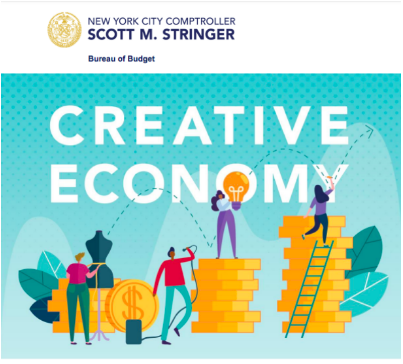New York City Comptroller Releases Report on the Creative Economy
Sunday, November 3, 2019
New York City Comptroller Releases Report on the Creative Economy

On October 25, Dance/NYC Executive Director Alejandra Duque Cifuentes offered remarks in support of the new, expansive report about the NYC creative sector released by New York City Comptroller Scott M. Stringer's office:
My name is Alejandra Duque Cifuentes and I am the Executive Director of Dance/NYC. As the service organization for the dance workforce in New York City, Dance/NYC’s mission is to promote the knowledge, appreciation, practice, and performance of dance in the New York metropolitan area area. We embed values of justice, equity, and inclusion into every aspect of the organization and work in alliance with the national service organization Dance/USA. We serve the dance community through 5 iterative programs including advocacy; research on the workforce; convening and professional development; grantmaking; and, technology and resources through our website dance.nyc.
It is a pleasure to be here today and celebrate this groundbreaking and critical report for the arts in NYC and extend our thanks on behalf of the dance community to New York City Comptroller Scott M. Stringer for his leadership in advocating for the needs of artists and the creative sector. The findings of this report echo what has been true of the dance workforce. Our 2016 State of NYC Dance and Workforce Demographics report revealed that dance nonprofits contributed nearly $730 million to the economy in NYC. And, this is only representative of incorporated and established groups. This does not account for the lion’s share of the workforce functioning outside of the nonprofit structure, often as fiscally-sponsored or independent artists. These artists, often working with small budgets, are the most adaptive and employ a workforce that is representative of the demography of our city; yet, they have the least access to funding and support. In a political climate that threatens the humanity and wellbeing of many New Yorkers, including immigrants, disabled, and people of color to name a few, artists are playing a key role in organizing us, sharing our stories, and continuing to highlight the creative and cultural capacity of our city and democracy. Culture moves faster than politics and ensures that our shared humanity is preserved. Let us therefore move beyond simply valuing the product of art and value the artists that make it by creating policies and structures that ensure equitable funding, living wages, and quality of life for the artistic communities that make NYC the vibrant cultural capital it is today.
Thank you once again, Comptroller Stringer, for this groundbreaking work and may we all continue to be New Yorkers for Dance.
Creative sector employs nearly 300,000 New Yorkers; spurs $110 billion in economic activity and accounts for one in every eight dollars of New York City’s annual economic output
Over one-third of creative sector workers are self-employed; many struggle with precarious employment and affordability
Comptroller unveils roadmap to build the creative economy of the future — promote and expand the creative sector, mitigate affordability issues, and address inequities and underrepresentation
New York, NY – New York City Comptroller Scott M. Stringer today released a comprehensive new report on the creative economy in New York City, showing that the creative sector spurs $110 billion in economic activity, employs nearly 300,000 New Yorkers, and now accounts for one out of every eight dollars of New York City’s annual economic output. The Comptroller’s analysis provides a comprehensive and up-to-date overview of the state of this iconic sector and its workforce – showcasing the sector’s importance to the city and identifying recommendations to build the creative economy of the future by strengthening the relationship between City government and creative institutions and programming.
“New York City is the creative capital of the world, and this report shows how the sector at the heart and soul of our city is also a pillar of our economy. From Broadway to local theater groups, film studios to artists’ studios, New York City’s creative sector is as much a core industry of our city as banking or real estate or law. We need to invest in strengthening the creative economy to support and recognize it as the engine of opportunity that it is,” said New York City Comptroller Scott M. Stringer. “New York City is the crossroads of creativity. This report provides a thoughtful and comprehensive roadmap for the City to fully realize the potential of the creative economy, expand opportunities to all New Yorkers, and build a thriving, diverse creative sector for the future.”
The State of the Creative Economy and the Creative Workforce Today
• The sector – comprising industries from the performing arts to advertising, film and television to museums and art galleries, publishing, fashion, design and architecture, as well as thousands of independent artists, designers and others — employs 293,000 people, pays $30 billion annually in earnings, and accounts for one in every eight dollars in economic output.
• The U.S. creative sector is increasingly concentrated in New York City. Twelve percent of creative sector jobs are located in the City – compared to 3 percent of all U.S. jobs – reaching as high as one in every 5 jobs nationally in the publishing, advertising, and fashion design industries.
• At the same time, volatile employment situations for some creative workers, high rates of self-employment, and a growing affordability crunch contribute to economic insecurity among much of the creative workforce, challenging New York City’s continued pre-eminence as a creative hub. Lack of diversity among creative workers also remains a challenge.
The Future of the Creative Economy
Comptroller Stringer’s report details a series of recommendations aimed at strengthening and sustaining the creative sector in New York City. In particular, the report emphasized the importance of establishing a comprehensive citywide strategy to sustain and promote this economically-important sector, better connect all New Yorkers with cultural opportunities and careers, and ensure that creative workers are equipped to continue to thrive in New York City.
These include:
• Better integrating the work of multiple City agencies and entities through the creation of a deputy-mayor level task force to elevate the attention and focus of City government on this critical sector. City entities that are most actively engaged with the sector include the Department of Cultural Affairs (DCLA), the Mayor’s Office of Media and Entertainment (MOME), New York City Economic Development Corporation (EDC), and NYC & Company.
• Creating and promoting Cultural Districts throughout the city modeled on existing districts such as Fifth Avenue’s Museum Mile, the Brooklyn Cultural District, Kaufman Arts District in Queens, and the Little Haiti Cultural and Business District in Flatbush to promote neighborhood cultural resources as engines of local development as well sources of community enrichment
• Help expand and diversify the sector by improving the capital funding process for non-profit organizations and cultural organizations so they can continue to provide opportunity and enrichment in communities.
• Incentivizing the conversion of industrial spaces such as former manufacturing or commercial sites for creative sector uses, and using existing public spaces such as New York City Department of Education (DOE) dance studios, music rooms, theaters, visual arts rooms and media arts rooms.
Deepen Connections to Local Communities
Comptroller Stringer’s report highlighted the need to better connect the city’s cultural organizations with local residents and communities, which can help promote diversity in the sector. In addition to the role Cultural Districts can play, recommendations detailed in the report included:
• Ensuring that every NYC public school student receives arts and creative education in schools and partnering with local arts organizations as resources for public school arts education.
• Bolstering support for arts programming for at-risk and underserved youth, including the criminal justice-involved, to create pathways for careers in the creative sector.
Supporting the Creative Workforce
Over one-third of the creative sector workforce were self-employed in 2017, leaving them especially economically vulnerable in a City with a growing affordability challenge. The Comptroller’s report outlines several proposals to support this significant segment of New York’s workforce by connecting them to benefits and protections available to most fulltime employees, including health insurance and retirement benefits, wage protection, and unemployment insurance. The recommendations include:
• Supporting state legislation to combat wage theft by broadening the New York State Department of Labor’s oversight and enforcement authority to ensure that freelancers receive the same wage protections as traditional employees.
• Supporting access to quality, affordable health insurance for all freelancers and creative workers, particularly as nearly 10 percent of creative workers in the city lack health insurance.
• Expanding unemployment benefits to creative and freelance workers.
• Creating new affordable housing and workspaces such as renovating industrial spaces to fit individual, communal, commercial, and residential needs of artists, freelancers, and creative workers.
Find the full report at comptroller.nyc.gov.




